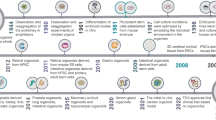Abstract
To develop an investigative tool for the study of human osteosarcoma (OSA), we established a human OSA cell line, namely, SOSP-9607, which exhibits a potential for spontaneous pulmonary metastasis. Subsequently, we screened two related sublines (F5M2 and F4) that have different pulmonary metastatic potentials. An in vivo orthotopic transplantation assay confirmed spontaneous pulmonary metastasis in all mice (100%) transplanted with the more aggressive OSA cells (F5M2) and a lesser degree of metastases with smaller nodules in 33.3% mice transplanted with the less aggressive OSA cell subline (F4). In mice transplanted with F5M2 cells, death from metastasis occurred at a median of 71 days; however, in mice transplanted with F4, no death occurred even after 120 days. Therefore, the F5M2 and F4 sublines, which originated from the same parent cell line, differed with respect to metastasis-related properties such as proliferating ability and invasiveness. Hence, these well-characterized human OSA sublines can be used as valuable models for comparative studies of genetic determinants of OSA in the future.







Similar content being viewed by others
References
Berlin O, Samid D, Donthineni-Rao R, Akeson W, Amiel D, Woods VL Jr (1993) Development of a novel spontaneous metastasis model of human osteosarcoma transplanted orthotopically into bone of athymic mice. Cancer Res 53:4890–4895
Crnalic S, Hakansson I, Boquist L, Lofvenberg R, Brostrom LA (1997) A novel spontaneous metastasis model of human osteosarcoma developed using orthotopic transplantation of intact tumor tissue into tibia of nude mice. Clin Exp Metastasis 15:164–172
Dass CR, Ek ET, Contreras KG, Choong PF (2006) A novel orthotopic murine model provides insights into cellular and molecular characteristics contributing to human osteosarcoma. Clin Exp Metastasis 23:367–380
Grenman R, Burk D, Virolainen E, Buick RN, Church J, Schwartz DR et al (1989) Clonogenic cell assay for anchorage-dependent squamous carcinoma cell lines using limiting dilution. Int J Cancer 44:131–136
Gupta GP, Massague J (2006) Cancer metastasis: building a framework. Cell 127:679–695
Khanna C, Prehn J, Yeung C, Caylor J, Tsokos M, Helman L (2000) An orthotopic model of murine osteosarcoma with clonally related variants differing in pulmonary metastatic potential. Clin Exp Metastasis 18:261–271
Khanna C, Khan J, Nguyen P, Prehn J, Caylor J, Yeung C et al (2001) Metastasis-associated differences in gene expression in a murine model of osteosarcoma. Cancer Res 61:3750–3759
Luu HH, Kang Q, Park JK, Si W, Luo Q, Jiang W et al (2005) An orthotopic model of human osteosarcoma growth and spontaneous pulmonary metastasis. Clin Exp Metastasis 22:319–329
Mankin HJ, Hornicek FJ, Rosenberg AE, Harmon DC, Gebhardt MC (2004) Survival data for 648 patients with osteosarcoma treated at one institution. Clin Orthop Relat Res 429:286–291
Minn AJ, Gupta GP, Siegel PM, Bos PD, Shu W, Giri DD et al (2005) Genes that mediate breast cancer metastasis to lung. Nature 436:518–524
Padua D, Zhang XH, Wang Q, Nadal C, Gerald WL, Gomis RR et al (2008) TGFbeta primes breast tumors for lung metastasis seeding through angiopoietin-like 4. Cell 133:66–77
Poste G, Fidler IJ (1980) The pathogenesis of cancer metastasis. Nature 283:139–146
Steeg PS, Bevilacqua G, Kopper L, Thorgeirsson UP, Talmadge JE, Liotta LA et al (1988) Evidence for a novel gene associated with low tumor metastatic potential. J Natl Cancer Inst 80:200–204
Tavazoie SF, Alarcon C, Oskarsson T, Padua D, Wang Q, Bos PD et al (2008) Endogenous human microRNAs that suppress breast cancer metastasis. Nature 451:147–152
Toh Y, Pencil SD, Nicolson GL (1994) A novel candidate metastasis-associated gene, mta1, differentially expressed in highly metastatic mammary adenocarcinoma cell lines. cDNA cloning, expression, and protein analyses. J Biol Chem 269:22958–22963
Woodhouse EC, Chuaqui RF, Liotta LA (1997) General mechanisms of metastasis. Cancer 80:1529–1537
Acknowledgments
This work is supported by two grants from the National Natural Science Foundation of China (No. 30330610 and No. 30873027). We would like to thank Professor Qiu Xiuchun for his technical help and Zhao Hong for his efforts in taking care of animals. We also thank Dr. Ji Zhengang for his valuable advice.
Author information
Authors and Affiliations
Corresponding author
Additional information
Xiang Chen and Tong-Tao Yang contributed equally to this work.
Rights and permissions
About this article
Cite this article
Chen, X., Yang, TT., Wang, W. et al. Establishment and characterization of human osteosarcoma cell lines with different pulmonary metastatic potentials. Cytotechnology 61, 37–44 (2009). https://doi.org/10.1007/s10616-009-9239-3
Received:
Accepted:
Published:
Issue Date:
DOI: https://doi.org/10.1007/s10616-009-9239-3




